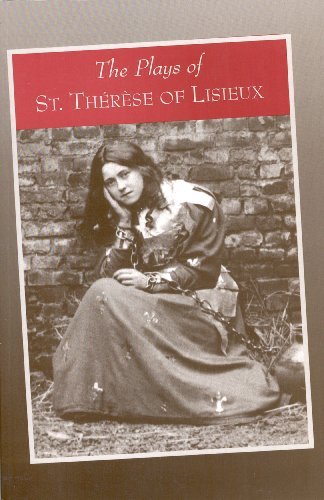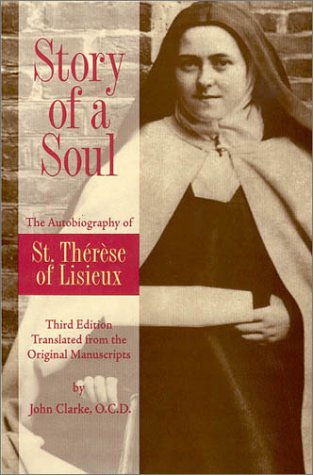Saint Therese of the Child Jesus
of the Holy Face
Entries by Maureen O'Riordan (555)
St. Therese of Lisieux honored by UNESCO in 2022-2023
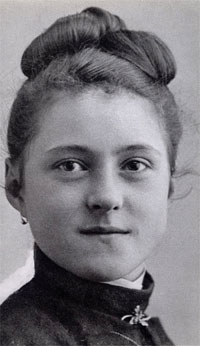
Every two years, UNESCO (the United Nations Educational, Scientific, and Cultural Organization) honors figures from around the world who have worked in the fields of Peace, Education, Sciences, Social Sciences, and Communication. In view of the 150th anniversary of Therese's birth, which will fall on January 2, 2023, the Shrine at Lisieux proposed St. Therese of Lisieux as a representative of France to be inscribed for this honor. Supported also by Italy and Belgium, the nation of France proposed Therese for this recognition. On November 11, 2021, the member countries of UNESCO's General Conference endorsed this choice.
For more about the significance of this great honor conferred on St. Therese by the United Nations, please see "The General Conference of UNESCO voted to celebrate the 150th anniversary of the birth of Therese de Lisieux (1873-2023)," at the Web site of the Shrine at Lisieux.
For the next two years, Therese will be celebrated around the world. The anniversary of her beatification will also be celebrated in 2023. Look for more news in the future.
"St. Stanislaus Kostka," the last play St. Therese of Lisieux wrote
Portrait of St. Stanislaus Kostka by Scipione Delfine, c. 1569. Public domain. Wikimedia Commons
On the feast of St. Stanislaus Kostka: For the golden jubilee of Sr. St. Stanislaus, celebrated on February 8, 1897, St. Therese, as de facto novice mistress, wrote the play, "St. Stanislaus Kostka," which the novices performed during the evening recreation.
The life of St. Stanislaus touched St. Therese in several ways. Like her, the young Polish man wanted to enter religious life (the Jesuits) very young. The opposition of his influential father made his local provincial hesitate to receive him, so he went on foot to Rome (450 miles!) and received permission to enter the Society there. He edified everyone by his piety and prayerfulness. He was a novice for only about nine months, for on August 15, 1568, he died of a lung disease.
Therese closes her play with Stanislaus confiding to the Blessed Virgin his great desire to continue to do good after his death. The Virgin Mary assures him that his desire will be granted. Please enjoy this little-known work, in which Therese expresses her own desires, at St. Stanislaus Kostka, courtesy of the Archives of the Carmel of Lisieux and the Washington Province of Discalced Carmelites. We pwe the valuable opportunity to read Therese's writings online to their generous collaboration.
For a fuller understanding of the play and of Therese's seven other religious plays, consult The Plays of St. Therese of Lisieux, general introduction by Guy Gaucher, O.C.D., translated by Susan Conroy and David J. Dwyer (Washington, D.C.: ICS Publications, 2008, pp. 322-354). The foreword to "St. Stanislaus Kostka" informs us about the jubilee celebration, the life of the young Stanislaus, the life and circumstances of Therese when she wrote this play, and details of the performance.
October 21, 1898: "Story of a Soul" published for the first time
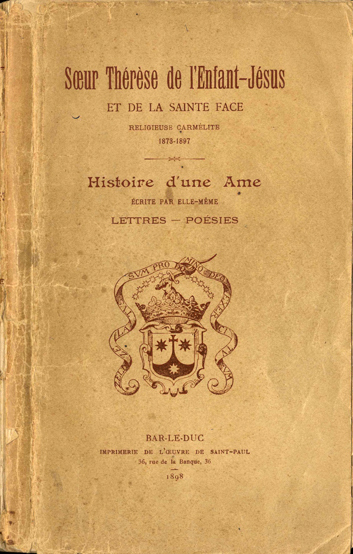 Archives of the Carmel of Lisieux
Archives of the Carmel of Lisieux
For a long time, the world believed that Therese's memoir was published on September 30, 1898, the first anniversary of her death. In fact, it did not appear till October 21, 1898.
See the story of the first publication of Story of a Soul in the article "Story of a Soul in the making: 1897-1898 - in the details" on the Web site of the Archives of the Carmel of Lisieux, which is the chief source of the brief historical details below. My thanks to the Archives.
Therese's uncle, Isidore Guerin, a chief benefactor of the Carmel, agreed to finance the printing of the first edition, 2,000 copies. The publication included not only a heavily edited version of Therese's memoir but also excerpts from her poems, prayers, what her sisters remembered, and a few other sources. The Carmel of Lisieux sent them to all the French Carmels and to a few foreign Carmels. They were also sold in bookstores.
The reaction to the book arrived within hours. The nuns received letters dated October 22, the very day after publication, speaking of the powerful spiritual influence of Therese's life. Read a selection of letters written by readers of Story of a Soul within the first six months after publication. I could not help noticing how many people were inspired by the family life of Louis and Zelie; understood that Therese's life was significant for lay persons, not only religious; and did not hesitate to call her a saint from the moment they first read her writings.
These manuscripts took the world by storm. Now that they have been available in various editions and in countless languages for more than 120 years, let's not take them for granted. I hope we will not hesitate to recommend them and to give them to everyone who can benefit from them.
Please note that as of 10/22/2021, ICS Publications is offering the book at half price ($6.98). Click on the image above to visit their site for details.
125 years ago with St. Therese: "St. Therese of Lisieux Novena 2021: Letter 197 (September 1896)," from the blog "Carmelite Quotes"
 used with the permission of the "Carmelite Quotes" blog
used with the permission of the "Carmelite Quotes" blog
It was 125 years ago, in the month of September 1896, that, at the request of her sister, Marie of the Sacred Heart, Therese wrote her "little doctrine," the third manuscript of Story of a Soul*, where she recounts her discovery of her vocation to be "love in the heart of the Church." She wrote this short manuscript during her annual private retreat, which she made, according to custom, near the anniversary of her profession (September 8, 1890). The manuscript is world-famous: the powerful exchange of letters it prompted between the two sisters (unfortunately not all included in Story of a Soul) less so. This year the distinguished Carmelite author of the "Carmelite Quotes" blog has prepared a novena based on Therese's letter to Marie (LT 197) explaining further her doctrine, which Marie had not fully understood at first. The author generously gave me permission to use her image above and to post a link to the "Introduction to the St. Therese of Lisieux Novena 2021: Letter 197" here. Nine days are too little to exhaust the riches of this letter, but God will give us the graces we need at each moment to absorb it.
I am posting only this link to the introduction; it's not necessary for me to post it every day. When you follow the link above, you will see that it contains a list of themes for each day of the novena. The link to Day 1 is already live, and, as the blogger publishes the novena day by day, the other links will come to life. This novena is an opportunity not only to ask for the favors we want but also to know more intimately the saint whose intercession we ask and to understand what God's mercy did in her. I'm fervently grateful to the author of Carmelite Quotes for giving us the opportunity to make this novena together.
Although I seldom make personal requests of my readers, this year I do not hesitate to ask you to remember, in this novena, my special intention. May Therese, the healer and thaumaturgist, implore God to grant it. Please accept my wholehearted thanks.
________________________
*Read this manuscript online at the Web site of the Archives of the Carmel of Lisieux.
Part II of "Promulgation of the Decree on the Heroic Virtue of the Venerable Sister Therese of the Child Jesus," August 14, 1921
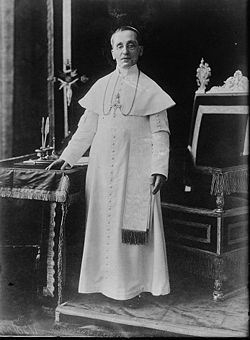 Pope Benedict XV during his reign. User:Czinitz at hu.wikipedia, Public domain, via Wikimedia Commons
Pope Benedict XV during his reign. User:Czinitz at hu.wikipedia, Public domain, via Wikimedia Commons
The Pope then began in Italian His masterly discourse, which lasted three-quarters of an hour. His speech was a "eulogy of the new "Venerable" who seems to have won his heart, and of whom he spoke with tenderness. Even if the translation of this remarkable oration, which has been kept as literal as possible, enables one to admire its theological power as well as the brilliancy of its diction and elegance of form, nothing can reproduce the eloquence and majesty of the August Orator. He was radiant; and every one of His graceful and expressive gestures marked His enthusiasm.
Mgr. Lemonnier afterwards, in conveying his personal impression, confessed that he had lost all idea of time under the charm of this discourse, its touch of the divine from beginning to end.
When the Pope had finished speaking the Most Reverend Father Postulator presented Him with a copy of the Decree tied with a white ribbon with gold border, and the other with violet ribbon, were presented to His Eminence, Cardinal Vico and to his Lordship, Mgr. Lemonnier. Then, copies of the Decree were distributed among the Assistants.
The Holy Father brought the proceedings to an end by imparting, with visible joy, the Apostolic Benediction, and regained His apartments with the usual ceremonial; then the spectators by degrees left the Consistorial Hall. The Bishop of Bayeux and Lisieux was surrounded, congratulated, and questioned on all sides. Then the crowd gradually dispersed, each one carrying away in his heart the memory of this never-to-be-forgotten ceremony.
[For a description of the events of August 14, 1921, a word picture written in those days before television, I’m indebted to the W.A. Record, a newspaper published in Perth in Western Australia. See “Promulgation of the Decree on the Heroic Virtues of the Venerable Sister Teresa of the Child Jesus (1922, January 21).” The W.A. Record (Perth, WA : 1888 - 1922), p. 1. Retrieved August 13, 2021, from http://nla.gov.au/nla.news-article212397672. I reproduce the end of this article above].
_____________________________________________________________________
I should like to note two other aspects of the significance of this speech of Pope Benedict XV: first, that this speech made Therese's sister Celine so happy that she was happier on August 14, 1921 than on the days when Therese was later beatified and canonized.
Celine's reaction to Pope Benedict's speech:
When the promoter of the faith asked me at the canonical process: “Why do you desire the beatification of Sister Thérèse of the Child Jesus?” I answered that it was solely that her Little Way might become known to the world. . . .
The promoter of the faith warned me, however: “Once you begin to speak of a special Way, the Cause is infallibly doomed; innumerable cases on record bear witness to that.”
“That is indeed too bad,” I replied, “but a fear of hindering the beatification of Sister Thérèse could never deter me from stressing the only important point that interests me—that her Little Way might be raised with her, so to speak, to the honors of the altar.”
Céline goes on,
[O]nly a few years later . . . the decree on the heroic . . . virtues of Sister Thérèse was promulgated by the Sovereign Pontiff, Benedict XV. On that day, August 14, 1921, when His Holiness in his discourse officially raised The Way of Spiritual Childhood to its exalted rank in the life of the Church, my joy reached heights never again attained, not even on those other memorable days when my little sister Thérèse was first beatified and then canonized by Holy Mother Church.1
[1] Last Conversations of St. Therese of Lisieux (Washington, D.C.: Washington Province of Discalced Carmelites, 1977, p. 212.
The Carmelites of Lisieux promulgating Pope Benedict XV's Speech
The Lisieux Carmelites wrote regularly to the Carmelites of Philadelphia, who, from their foundation in 1902, had been spreading the knowledge of Therese to the whole United States. On January 2, 1922, Sister Anne of Jesus, a Canadian nun who had entered the Lisieux Carmel, wrote to Sister Ignatius of the Philadelphia Carmel:
The copies of the speech of the pope were sent to you for free distribution; I had asked Imprimerie St. Paul [St. Paul’s Printing Press] to put a card stating they were offered to you with our compliments. This speech is so full of light on the way of spiritual childhood that we like to spread it as much as possible, especially among priests.
Read the letter from Sister Anne of Jesus to Sister Ignatius, January 2, 1922, on the Web site of the Philadelphia Carmel.
References:
Note that this is an affiliate link; you can support this Web site by purchasing the book through the link.
